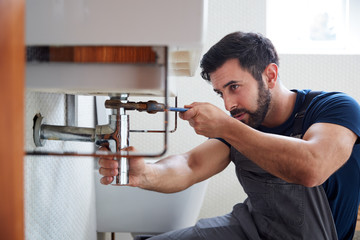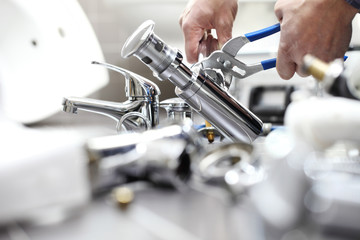The Importance of Commercial Plumbing
Commercial plumbing involves the installation, repair, and maintenance of piping and fixtures in retail outlets, restaurants, office buildings, and more. The systems are often used much more than in residential homes, increasing the risk of damage.
When problems arise, they must be fixed quickly to avoid disruptions to business operations. Contact Woodlands Plumbing for professional help.
Commercial plumbing deals with buildings that need a larger water supply system and are likely to be used more often than residential buildings. This means that the pipes and systems are more prone to wear and tear and will require more frequent maintenance. Commercial plumbing also works with a wider variety of building materials and structures than residential plumbing, including malls, office buildings, hospitals, and restaurants. This makes it important for commercial plumbers to have a wide range of skills and knowledge.
In addition, large commercial buildings typically have more floors and a greater number of toilets and sinks than residential buildings. This creates a complex system that is difficult to navigate when problems occur. As a result, it is essential for commercial plumbers to be familiar with the building structure and layout in order to quickly locate and repair issues.
A clogged toilet in a residential home might cause some inconvenience, but a broken pipe in a commercial building can disrupt business and even lead to health issues for employees or customers. This is why it is crucial for commercial plumbing companies to have the right tools and equipment for the job.
One of the most significant differences between residential and commercial plumbing is size. A residential plumbing system usually serves a single family, so it is relatively simple and straightforward. Commercial plumbing, on the other hand, must accommodate a much wider range of people and needs, including specialized fixtures for businesses such as restaurants or hospitals.
Another difference between residential and commercial plumbing is the size of the pipes. Residential pipes are usually small and made of sturdy plastic or copper. In contrast, commercial pipes are typically large and made of industrial-grade steel. This is because the pipes must be able to handle high water pressure and a greater volume of water than residential pipes can.
In addition, commercial plumbing is often required in buildings that are too tall to be supplied by normal municipal water pressure. This creates a number of challenges for commercial plumbers, who must be able to work with both low and high-pressure water systems.
Health Code Requirements
In commercial buildings, the plumbing systems must comply with strict health and safety regulations. This includes ensuring that there are enough water pressure and adequate drainage systems to avoid potential leaks or bursts that could disrupt business operations. The rules also cover sanitation and waste management. By following these guidelines, businesses can reduce the risk of dangerous bacteria, clogs, and unpleasant odors.
The health code requires that plumbing fixtures be properly sized to ensure they are not overloaded. It also requires that a drain line be sloped to the nearest sanitary sewer system to prevent wastewater from backing up into bathrooms and kitchens. In addition, all piping must be made of materials that are safe for use in potable water systems and have smooth interior surfaces to prevent buildup and scale formation.
Another important requirement of the health code is backflow prevention, which involves installing devices to prevent contaminated water from entering the main drinking water supply. This is particularly important in establishments with cross-connections, such as restaurants and healthcare facilities. Backflow prevention devices include check valves, pressure vacuum breakers, and combination vacuum breakers/backflow preventers.
In addition, the health code requires that all toilets be supplied with a flushing device that can hold and support a full load of water. It also requires that the pan drain extends a minimum of 6 inches and terminate at a point where it can be easily observable by building occupants. The drain lines must be sloped a minimum of 1/4 inch per foot to prevent the accumulation of solids in the piping.
It is also important that the sanitary piping systems in commercial buildings be properly vented to avoid stale air and excessive moisture buildup. These systems should be vented to a point outside the building or at least through an exterior wall or roof, and they must be protected from inclement weather conditions. The venting systems must be sized to accommodate the anticipated flow rate and provide sufficient capacity to remove the vapors generated by the hot and cold water systems.
There are also rules concerning the design of gas systems in commercial structures, which must be complied with to avoid leaks or explosions. These rules require that all piping be installed using proper procedures and that the gas meters are inspected regularly. The piping must also be insulated to protect against heat loss and be properly sized for the expected flows.
Maintenance Contracts
Often, the best way to retain customers is through ongoing maintenance services. To facilitate these arrangements, plumbers should develop and utilize plumbing contracts that clarify the details of the work to be performed, a timeline for completion, compensation, and payment arrangement as well as any reimbursable expenses that may arise. Typically, contracts should also include a list of all facilities to be maintained and specify whether the contract will cover a single job or span a period of time. If the latter, contractors should state how often the maintenance will be performed and specify any recurring activities that will take place, such as checking pilot lights, flushing drains, and testing for leaks.
The marketing of these agreements often projects them as comprehensive safety nets, with the idea being that regular inspections and care thwarts major problems, saving homeowners from exorbitant repair costs. This is an appealing narrative, but scrutiny should be applied to the likelihood of such savings and if the fees charged for the services warrant them.
Critics tend to point out that set maintenance schedules might not align with actual need, potentially incurring charges for redundant services. But advocates of these contracts often point to the expertise brought by professional plumbers. These experts bring a depth of knowledge and experience that can spot issues an untrained eye might miss, possibly preventing costly repairs down the line.
In any case, the most important consideration is the customer relationship. Maintaining a reliable and trustworthy customer base is key for the profitability of any plumbing business, whether the focus is on residential or commercial. And that translates into the need for a robust system for managing customer information, including current addresses and equipment, past visits, and preferences for scheduling, billing, and payment terms.
Software that is designed for this purpose makes it easy for plumbing contractors to manage their membership programs. ServiceTitan, for example, has a sleek PDF form that collects and organizes the customer information that a contractor needs to keep track of: membership information, service plans, coverage periods, Good-Better-Best options, service notes, and more. This information is then consolidated for reporting and scheduling purposes.
Regulations
Plumbing regulations are designed to protect occupants of commercial buildings from health risks, property damage, and other potential hazards that may result from faulty installation or non-compliant systems. Failure to adhere to these standards can lead to expensive repairs, legal complications, and negative reputation damage. Therefore, it’s vital that businesses prioritize compliance with these standards and remain up to date on all current requirements.
Regular inspections and maintenance are essential to ensuring plumbing code compliance in commercial structures. These steps help identify and address any issues before they become problematic and costly. In addition, it’s important to work with a licensed and qualified plumber who understands and complies with local codes and requirements.
The quality of plumbing fixtures and equipment is also crucial for achieving and maintaining compliance. Pipes and fixtures should be installed using appropriate materials, and they must meet all applicable pressure and flow requirements. Additionally, they must be tested and approved by a third-party to ensure their safety and effectiveness.
Another common requirement is the venting of wastewater from toilets, drains, and other fixtures to prevent clogs and backflow. This involves the use of a venting system that extends from each fixture to the outside, and a check valve in the vent line to prevent reverse flow. Finally, all pipes should be sized appropriately to accommodate water demand, minimize the risk of cross-connections, and comply with the code’s requirements.
In addition to addressing safety and sanitation concerns, plumbing codes are designed to promote energy efficiency and sustainability in commercial structures. Plumbing systems that comply with these codes are more efficient and conserve water, which can help businesses save on utility costs in the long run.
Overall, plumbing codes and standards offer numerous benefits for both building owners and occupants alike. They prioritize the safety of occupants, protect against water damage and contamination, enhance energy efficiency, preserve the lifespan of plumbing infrastructure, and ensure legal compliance. By prioritizing compliance and keeping up to date on all regulatory changes, businesses can provide safe, secure, and hygienic premises for their occupants.



